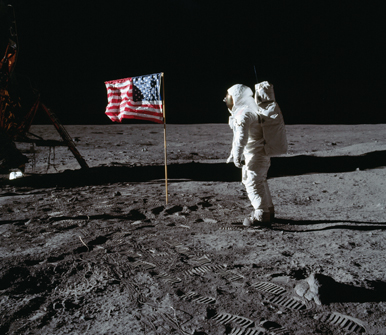
1946: President Harry Truman signed legislation establishing the National Air Museum, but the bill didn’t allow for the construction of a new venue. Instead, planes, missiles, and other items were housed in the Smithsonian Arts and Industries Building; the Smithsonian Aircraft Building, known as the “Tin Shed,” behind the castle; and storage facilities in Illinois and Maryland, before Congress approved funding for a new Air and Space Museum on the National Mall in 1971. The largest of the 19 Smithsonian museums, it has welcomed 311 million visitors since opening in 1976.
1969: That’s one small step for man, one giant leap between lectures. AU students, faculty, and staff were among 500 million people around the world who watched, spellbound, on Sunday, July 20, as US astronaut Neil Armstrong became the first person to step foot on the moon. AU President George H. Williams made a long weekend of the historic event, closing AU on July 21 “in response to President Richard M. Nixon’s request for a National Day of Participation.” The closure didn’t apply to a few unlucky students, who still had to take comprehensive exams that Monday.
1990: Apollo 11 astronaut Buzz Aldrin participated in a Kennedy Political Union (KPU) panel about America’s future in space, advocating for NASA’s return to the moon as a buildup to Mars exploration. “I would not like to see us do an Apollo again—that is, going to the moon several times and then waiting around for 30 or 40 years before we do it again.”
1999: The second man on the moon made his second visit to AU for a KPU talk, reiterating his desire for humans to end their “confinement to one vulnerable world” and shoot for the red planet. Aldrin’s talk preceded
AU’s Space Exploration at the Millennium conference, which brought to campus 2,000 visitors, the Sojourner Mars rover, an Apollo 16 moon rock, and Bill Nye the Science Guy.
2019: Smithsonian’s Destination Moon: The Apollo 11 Mission, which celebrates the 50th anniversary of the moon landing, began a six-month run at Seattle’s Museum of Flight in April. The two-year traveling exhibit, which made stops in Houston, St. Louis, and Pittsburgh, took the 13,000-pound command module Columbia on the road for the first time since 1971. When Destination Moon returns to Air and Space in 2020, it will have traveled about 8,000 miles—945,000 shy of the Apollo 11 mission.